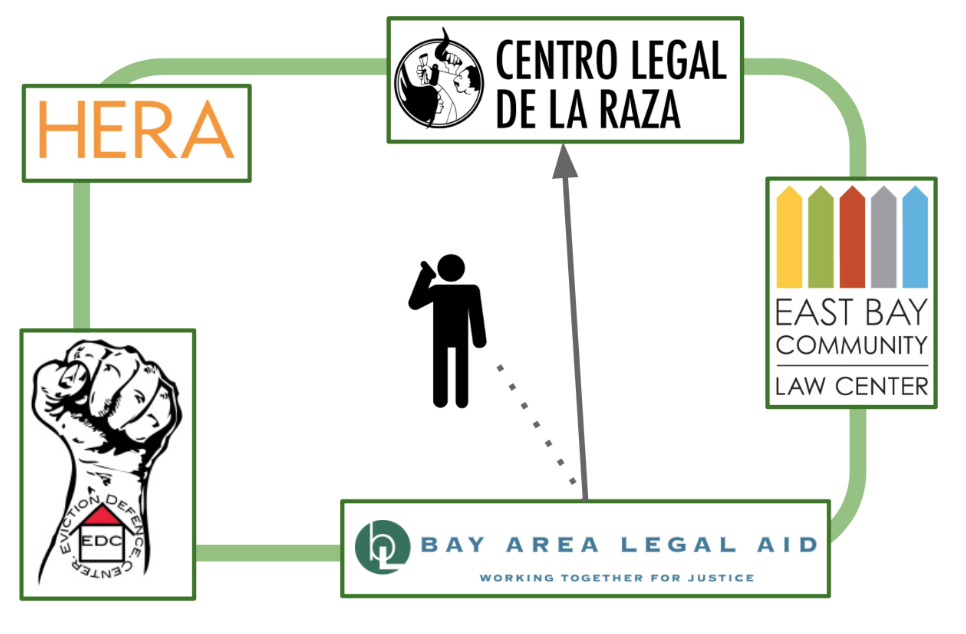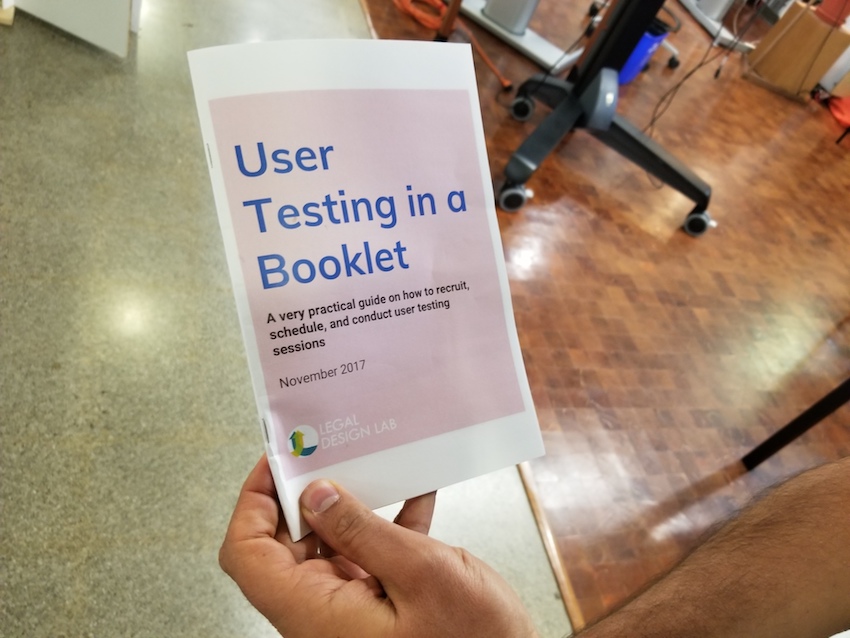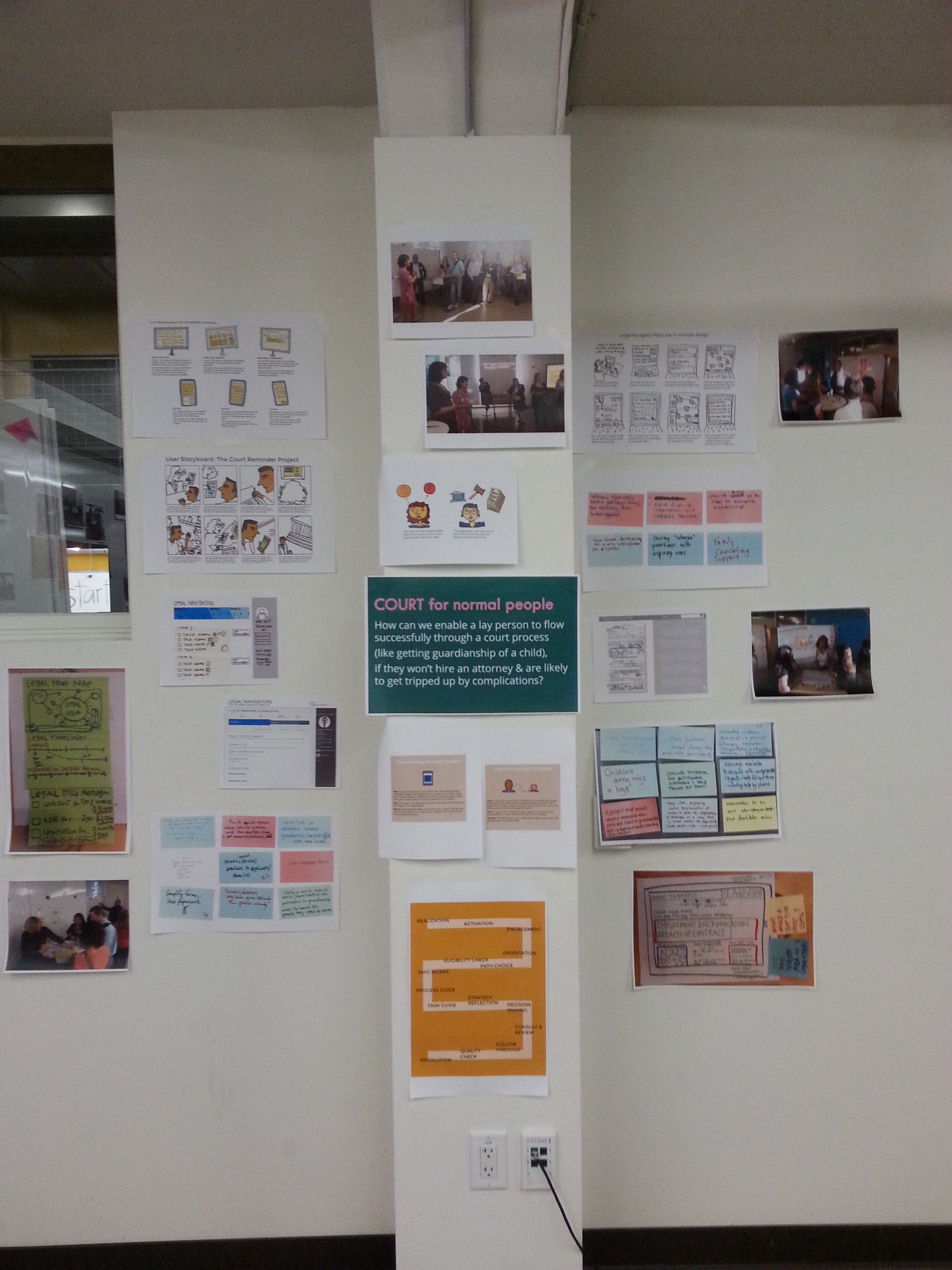by Jane Wong, Stanford Legal Design Lab fellow
this piece was originally published on Legal Design and Innovation
I am pleased to share some exciting new developments in our effort to unify the intake systems of legal aid nonprofits in the Bay Area. To recap my April update, Project Legal Link’s Sacha Steinberger and I have partnered with five housing law nonprofits in Alameda County to pilot this ambitious vision. These nonprofits are Bay Area Legal Aid, Centro Legal de la Raza, East Bay Community Law Center, Eviction Defense Center, and Housing & Economic Rights Advocates.
This decision was made in response to a new anti-displacement grant from Alameda County to these nonprofits. Besides increasing their legal capacity, the grant requires the five organizations to work together in a more coordinated manner so that county residents can quickly identify and connect to the one that best meets their needs.
The scope of the pilot—dubbed “Peer to Peer” or “P2P” for short—is to create a coordinated referral system that enables each housing law nonprofit (1) to determine which of the other four housing law nonprofits is the best fit for someone when they are found ineligible and (2) to seamlessly connect that person to the appropriate nonprofit. Our hypothesis is that improving service coordination among these nonprofits will reduce their duplication of effort and time and ultimately increase access to timely legal services for their clients.
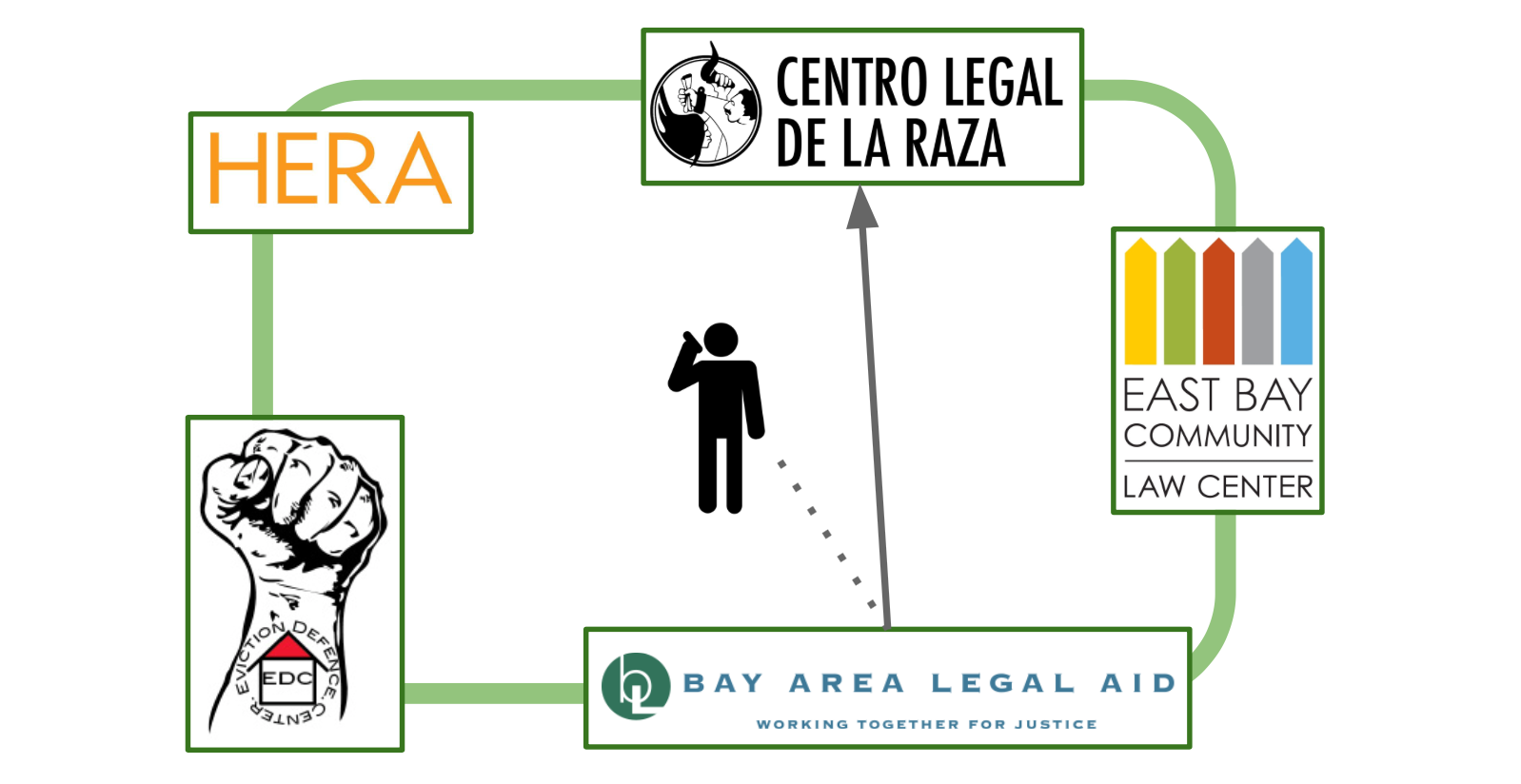
Our Team’s Newest Addition
Since my April update, our two-person design team has grown to include Keith Porcaro as system architect. Keith will stay on the project through 2019, guiding its transition from our current, low-tech prototype to the envisioned high-capacity software program. Thanks to his extensive experience advising legal nonprofits in technology, Keith has transitioned quickly to the project.
Legal Matchmaking
Using the interviews that Sacha and I conducted in the spring, Keith has played a leading role in creating an eight-page “referral worksheet” — a comprehensive decision tree that incorporates the service priorities of all five housing law nonprofits. This worksheet consolidates our research, and is organized by the factors we found are most important in the first step of triage: location, legal service (e.g. unlawful detainer notice), and the type of housing (market rate, rent controlled, or subsidized). Now, when a housing law nonprofit finds they cannot serve a particular client, they can use this referral worksheet to quickly and accurately determine which of the other four housing law nonprofits in the county might be able to serve that client.
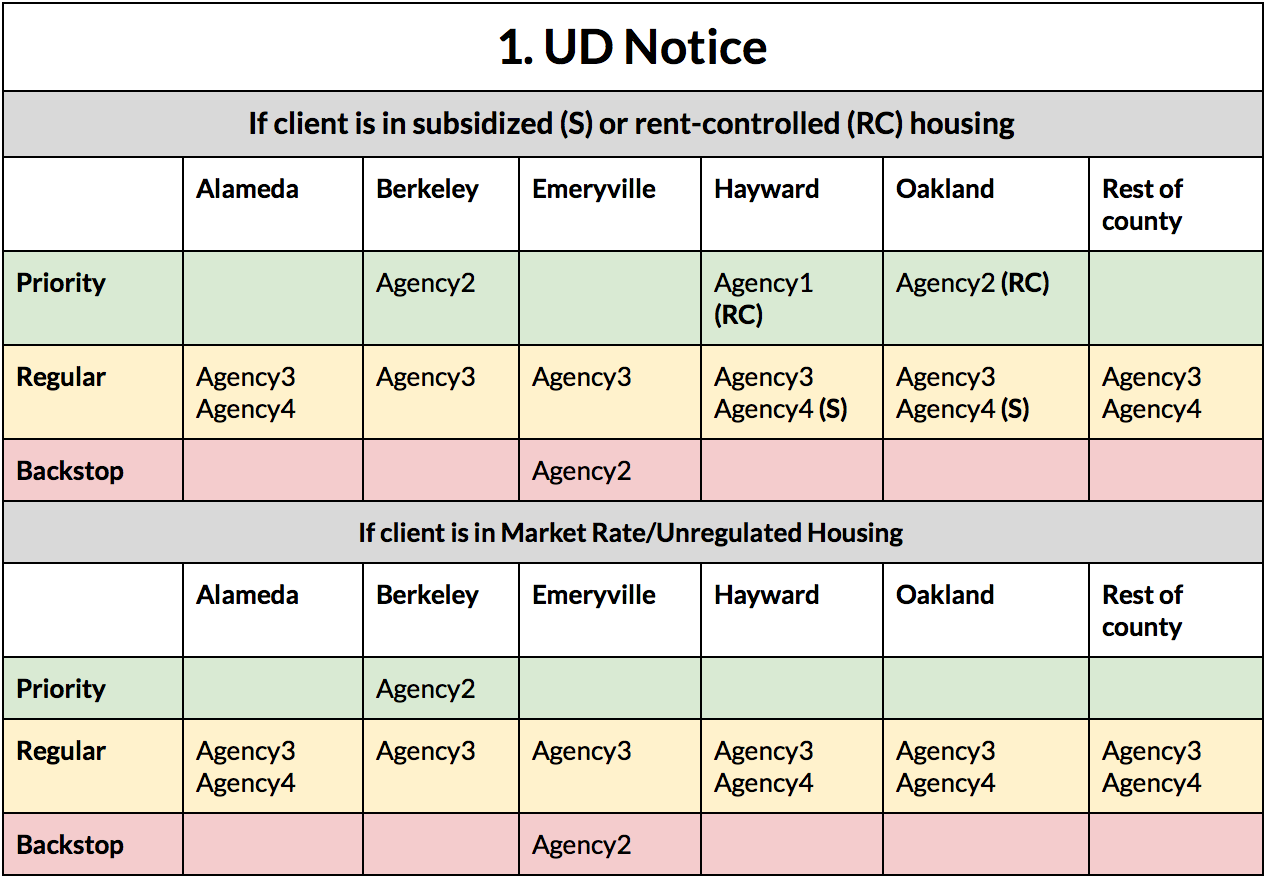
This particular referral worksheet is especially valuable, because the five housing law nonprofits have been actively involved in shaping its triaging criteria and keeping the data fields updated. This is no small feat, considering that (1) the providers do not have a uniform taxonomy for housing law issues and (2) their service offerings frequently change, as is the case with many nonprofits with shifting funds.
After this first step of triage, the referring nonprofit can then pull up information about the other nonprofits to further verify the client’s eligibility. In this second tier check, the most critical data are the organizations’ income thresholds and any other factors that might disqualify a client. For example, some nonprofits require a certain immigration status, and other nonprofits cannot handle disputes between tenants. We call these the “hard stops”. They aren’t exhaustive of each nonprofit’s priorities or preferences, but rather are the hard lines beyond which we know they cannot serve clients.
The Right Technological Fit
Our design team also examined what level of technology would be most appropriate in the interim referral system and in the final one, based on the capacities of the nonprofits. In our interviews, we found that the nonprofits differed in their software programs for email and for case management, making interoperability among them a challenge.
At the same time, we knew that Centro Legal de la Raza, the lead nonprofit in the county’s grant, was already using Salesforce as their case management system. Further, the grant was set to provide Salesforce licenses to the other four nonprofits to facilitate their data reporting to Centro Legal. This made Salesforce an attractive option, since we wanted to choose a platform that the nonprofits would be using. Further, we learned that we could build the necessary functions of the referral system into Salesforce. Thus, we decided that the most logical and resource-sensitive platform to build the final referral system on would be Salesforce.
As for the six-month interim system, we are treating it as a low-tech prototype that allows us to quickly test the concept of a coordinated referral system in this context, to obtain feedback from the nonprofits for future iteration, and to gather basic data on the volume and nature of referrals that occur. In its current state, the interim system is very manual, requiring the nonprofit staff to consult our referral worksheet and to share referrals via email.

To explain the new interim system, our team drafted custom, step-by-step instructions for each nonprofit on how they should handle incoming and outgoing referrals. Because each nonprofit has different organizational protocols, we mapped out each of their business processes to minimize any burden that this new system might impose. These new “workflows” underwent extensive revisions in response to multiple rounds of feedback from the nonprofits.
Launch
After a couple months of refining the components of the interim system, we scheduled a launch date in mid-July. The week prior, we visited each of the five nonprofits in Oakland and Berkeley and conducted a training at each one. Even at this point in the process, we gathered substantial feedback from the nonprofits about the system design, which we documented for later iteration.
Finally, the interim system launched on Monday, July 23. We decided to wait one month before gathering data from the nonprofits, to give them time to adjust to the new system.
Improving the Interim System
During the first month, we regularly checked in with the nonprofits about their transition to the interim system and fielded questions as they arose. One recurring piece of feedback from the nonprofits was that the process of using the multi-page referral worksheet and other documents was too time-consuming.
In response to this feedback, Keith prototyped a website — dubbed the “P2P Hub” — that allows the nonprofits to select the appropriate factors about the client and legal issue and to automatically see the results. Please note, the image below does not depict the final version of the website.
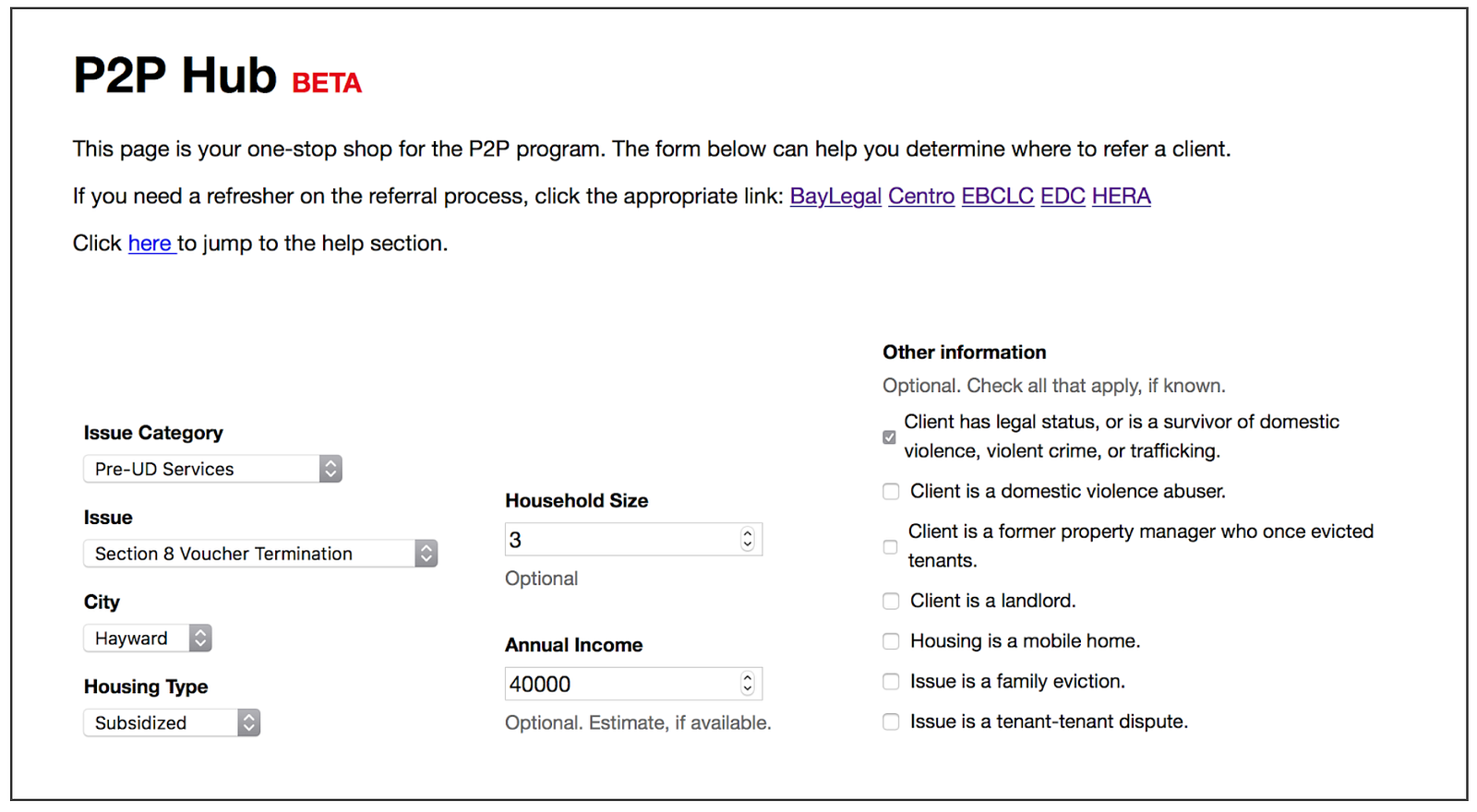
The Perspective of Legal Aid Clients
In my last update, I wrote that a missing piece in my research has been the perspective of legal aid clients — the ultimate beneficiaries of this unified intake project and the end-users of legal aid services. So I designed a small-scale study to survey renters in Alameda County about their experiences seeking legal aid for housing problems. In July, I received approval from Stanford’s Institutional Review Board, and I have been recruiting and surveying renters in the county since then.
Though I have only received a handful of responses so far, I am still gathering more. And the responses I have received provide some insight into the housing problems that renters face, the actions they take in response to a housing problem, which nonprofits they turn to in the county, their level of satisfaction with the services received, what they like and don’t like about the services received, and how easy or hard it is to find legal help.
Given the limited time left in my fellowship, which ends in August 2018, I structured the study to have only 30 respondents. Thus, I will not be able to make broad generalizations from these answers. However, I believe that the qualitative findings from these answers will provide a valuable starting point for understanding the needs and preferences of low-income residents in the county. These findings will help the design team and nonprofit partners to remain user-centered as they prototype and iterate the final referral system.
What’s Next
Our design team will continue to monitor the operation of the interim referral system with the five participating housing law nonprofits, collecting their feedback and providing assistance as necessary. Meanwhile, Keith will be working with Centro Legal de la Raza’s Salesforce consultant to figure out how to build the functions of the interim referral system into Salesforce. We anticipate transitioning from the interim system to the final one next year.
Every month, the nonprofits will provide us with data on the referrals they are making and receiving. At minimum, this information will inform our design of the final system. More excitingly, it will also shed light on which clients need help and aren’t getting it, which needs are going unmet, where there is a lack of services, and what opportunities exist to streamline services and/or bolster them.
We have also learned about San Francisco’s plans to build a streamlined referral system for coordinating eviction defense work. We look forward to sharing our learnings with them and any other jurisdictions that see the benefit of this work.
